| |
 |
 |
 |
|
 |
 |
 |
 |
 |

|
 |
 |
|
|
|
 |
NSF Support Helps Start a Robot Soccer Dynasty
|
 |
| |
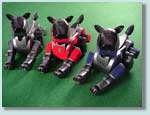 Since receiving her doctorate in 1992, Manuela Veloso's research interests in artificial intelligence have focused on duplicating the success with which humans plan, learn and execute tasks. Founding a robot soccer dynasty was purely coincidental, but a logical result of putting her research into practice with her students. Veloso and her students in the multi-robot CORAL Lab (Cooperate, Observe, Reason, Act, and Learn) at Carnegie Mellon University in Pittsburgh have pursued research to program a robot—and teams of robots—to make plans, carry them out, and learn from their successes and failures. Not to mention scoring enough goals to win a few robot soccer world championships in the process. Veloso's work has been supported by a 1995 CAREER award and a subsequent 1999 award from the National Science Foundation. Since receiving her doctorate in 1992, Manuela Veloso's research interests in artificial intelligence have focused on duplicating the success with which humans plan, learn and execute tasks. Founding a robot soccer dynasty was purely coincidental, but a logical result of putting her research into practice with her students. Veloso and her students in the multi-robot CORAL Lab (Cooperate, Observe, Reason, Act, and Learn) at Carnegie Mellon University in Pittsburgh have pursued research to program a robot—and teams of robots—to make plans, carry them out, and learn from their successes and failures. Not to mention scoring enough goals to win a few robot soccer world championships in the process. Veloso's work has been supported by a 1995 CAREER award and a subsequent 1999 award from the National Science Foundation.
Image courtesy: CMPack'02 research team: Manuela Veloso, Scott Lenser, Douglas Vail, Maayan Roth, Ashley Stroupe and Sonia Chernova. Photo by Debra Tobin.
Read the full story . ... Posted
4/29/03
|
 |
Bread Mold Yields a Genome First for Filamentous Fungi; Neurospora's 10,000 genes include RIPs that limit new genes
|
 |
| |
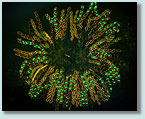 With more than 10,000 genes amid DNA strands of nearly 40 million base pairs, the first genome of a filamentous fungus has been sequenced through the cooperative efforts of a community of more than 70 scientists, culminating a two-year, $5 million effort supported by the National Science Foundation. The work is reported in the April 24 issue of Nature, which celebrates the 50th anniversary of that journal's publication of the structure of DNA. At the center of this latest genetics achievement is a filamentous fungus, a bread mold, a life form easily overlooked in the shadow of the Human Genome Project. To biologists, however, it is Neurospora crassa, an organism of historic and enduring value as a model organism. With more than 10,000 genes amid DNA strands of nearly 40 million base pairs, the first genome of a filamentous fungus has been sequenced through the cooperative efforts of a community of more than 70 scientists, culminating a two-year, $5 million effort supported by the National Science Foundation. The work is reported in the April 24 issue of Nature, which celebrates the 50th anniversary of that journal's publication of the structure of DNA. At the center of this latest genetics achievement is a filamentous fungus, a bread mold, a life form easily overlooked in the shadow of the Human Genome Project. To biologists, however, it is Neurospora crassa, an organism of historic and enduring value as a model organism.
Image courtesy: Dr. Namboori B. Raju of Stanford University
Read the full story . ... Posted
4/28/03
|
 |
Mosaic Web Browser Celebrates 10th Birthday; NSF-supported supercomputer center gave birth to software that spurred the development of the modern Web
|
 |
| |
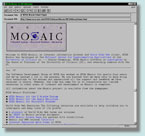 Ten years ago, the world's first freely available Web browser to allow Web pages to include both graphics and text was developed by students and staff working at the National Science Foundation (NSF)-supported National Center for Supercomputing Applications (NCSA) at the University of Illinois, Urbana-Champaign. The Mosaic Web browser spurred a revolution in communications, business, education, and entertainment that has had a trillion-dollar impact on the global economy. To celebrate the 10th anniversary of Mosaic's release, NCSA is holding a panel discussion April 29 to explore the future of computing and networking with five of the nation's leading technologists. Ten years ago, the world's first freely available Web browser to allow Web pages to include both graphics and text was developed by students and staff working at the National Science Foundation (NSF)-supported National Center for Supercomputing Applications (NCSA) at the University of Illinois, Urbana-Champaign. The Mosaic Web browser spurred a revolution in communications, business, education, and entertainment that has had a trillion-dollar impact on the global economy. To celebrate the 10th anniversary of Mosaic's release, NCSA is holding a panel discussion April 29 to explore the future of computing and networking with five of the nation's leading technologists.
Image courtesy: National Center for Supercomputing Applications/University of Illinois Board of Trustees
Read the full story . ... Posted
4/25/03
|
 |
U.S. and Japan Sign Memorandum of Cooperation for Integrated Ocean Drilling Program; Program will foster continued study of Earth's geologic processes
|
 |
| |
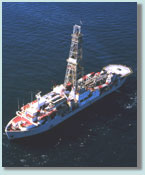 The
United States and Japan have signed a Memorandum of Cooperation, effective
April 22, 2003, to proceed with the Integrated Ocean Drilling Program
(IODP). The program will be co-led by the U.S. National Science Foundation
(NSF) and the Ministry of Education, Culture, Sport, Science and Technology
(MEXT) of Japan and will use cores of sediment and rock from the ocean
floor to study the geologic processes that modify our planet, the history
of those changes in oceans and climate and the extent and depth of the
planet's biosphere. Although NSF and MEXT will provide the primary scientific
facilities for IODP, significant scientific and financial participation
is expected from European and Asian nations. IODP is scheduled to begin
on October 1, 2003, and will have an initial duration of 10 years. The
United States and Japan have signed a Memorandum of Cooperation, effective
April 22, 2003, to proceed with the Integrated Ocean Drilling Program
(IODP). The program will be co-led by the U.S. National Science Foundation
(NSF) and the Ministry of Education, Culture, Sport, Science and Technology
(MEXT) of Japan and will use cores of sediment and rock from the ocean
floor to study the geologic processes that modify our planet, the history
of those changes in oceans and climate and the extent and depth of the
planet's biosphere. Although NSF and MEXT will provide the primary scientific
facilities for IODP, significant scientific and financial participation
is expected from European and Asian nations. IODP is scheduled to begin
on October 1, 2003, and will have an initial duration of 10 years.
Image courtesy: Texas A&M University
Read the full story . ... Posted
4/23/03
|
 |
Shining Light on the Nanoscale
|
 |
| |
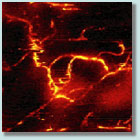 Researchers have created the highest-resolution optical image ever, revealing structures as small as carbon nanotubes just a few billionths of an inch across. The new method, developed by scientists at the University of Rochester, with colleagues from Portland State University and Harvard University, should literally shed light on previously inaccessible chemical and structural information in samples as small as the proteins in a cell's membrane. "This is the highest-resolution optical spectroscopic measurement ever made," said Lukas Novotny, professor of optics at Rochester. "There are other methods that can see smaller structures, but none use light, which is rich in information." The research, which appeared in the March 7, 2003, issue of Physical Review Letters, was supported by NSF. Researchers have created the highest-resolution optical image ever, revealing structures as small as carbon nanotubes just a few billionths of an inch across. The new method, developed by scientists at the University of Rochester, with colleagues from Portland State University and Harvard University, should literally shed light on previously inaccessible chemical and structural information in samples as small as the proteins in a cell's membrane. "This is the highest-resolution optical spectroscopic measurement ever made," said Lukas Novotny, professor of optics at Rochester. "There are other methods that can see smaller structures, but none use light, which is rich in information." The research, which appeared in the March 7, 2003, issue of Physical Review Letters, was supported by NSF.
Image courtesy: The Institute of Optics, University of Rochester.
Read the full story . ... Posted
4/18/03
|
 |
Long-Term Ecological Research Reveals Unusual Winter Lake-Ice Conditions
|
 |
| |
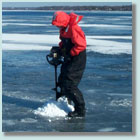 Winter residents of Madison, Wisconsin, expect their lakes to be rock-hard with thick ice for ice-fishing, ice-skating, and ice boating. However, this past winter the ice in some Madison-area lakes was not safe for winter sports.
According to Richard Lathrop, a scientist at NSF's North Temperate Lakes Long-Term Ecological Research (LTER) site, researchers' routine sampling of lake ice showed that while the top ice layer was hard, the majority of the underlying ice was soft and variable in thickness. The unusual conditions are consistent with LTER research that suggests winter ice around the world is not lasting as long due to global climate changes, said Henry Gholz, LTER program director at NSF. Winter residents of Madison, Wisconsin, expect their lakes to be rock-hard with thick ice for ice-fishing, ice-skating, and ice boating. However, this past winter the ice in some Madison-area lakes was not safe for winter sports.
According to Richard Lathrop, a scientist at NSF's North Temperate Lakes Long-Term Ecological Research (LTER) site, researchers' routine sampling of lake ice showed that while the top ice layer was hard, the majority of the underlying ice was soft and variable in thickness. The unusual conditions are consistent with LTER research that suggests winter ice around the world is not lasting as long due to global climate changes, said Henry Gholz, LTER program director at NSF.
Image courtesy: North Temperate Lakes Long-Term Ecological Research (LTER) Site.
Read the full story . ... Posted
4/18/03
|
 |
Science Board Calls for Greater Infrastructure Fiscal Support, Mid-Size Project Emphasis
|
 |
| |
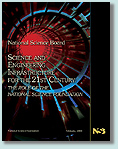 The
National Science Board (NSB) recently released
a report concluding that funding for academic research infrastructure "has
not kept pace with rapidly changing technology, expanding research opportunities,
and an increasing number of (facility) users." It recommended increased
funding and attention be devoted to science
and engineering (S&E;) research
infrastructure at the nation's colleges and
universities to achieve maximum results at these institutions, which
represent the vast majority
of the nation's base of support for fundamental
research. The
National Science Board (NSB) recently released
a report concluding that funding for academic research infrastructure "has
not kept pace with rapidly changing technology, expanding research opportunities,
and an increasing number of (facility) users." It recommended increased
funding and attention be devoted to science
and engineering (S&E;) research
infrastructure at the nation's colleges and
universities to achieve maximum results at these institutions, which
represent the vast majority
of the nation's base of support for fundamental
research.
Read the full story . ... Posted
4/10/03
|
 |
Visitors to Experience "Virtual Monticello" at New Orleans Museum of Art Exhibition; Computer graphics researchers to provide “virtual reality windows” into the past
|
 |
| |
 Visitors to the New Orleans Museum of Art (NOMA) this spring and summer will have a chance to peek in the windows of Monticello, Thomas Jefferson's home a thousand miles away in Virginia, thanks to University of North Carolina and University of Virginia computer graphics researchers who have devised a way to capture and display three-dimensional scans of Monticello's rooms. As part of the exhibition “Jefferson's America & Napoleon's France,” which runs April 12 through August 31 to celebrate the 200th anniversary of the Louisiana Purchase, NOMA has constructed a façade of Monticello at nine-tenths scale for which the researchers, led by Anselmo Lastra and Lars Nyland at North Carolina and David Luebke at Virginia, have provided “virtual reality windows.” Their work is supported by the National Science Foundation. Visitors to the New Orleans Museum of Art (NOMA) this spring and summer will have a chance to peek in the windows of Monticello, Thomas Jefferson's home a thousand miles away in Virginia, thanks to University of North Carolina and University of Virginia computer graphics researchers who have devised a way to capture and display three-dimensional scans of Monticello's rooms. As part of the exhibition “Jefferson's America & Napoleon's France,” which runs April 12 through August 31 to celebrate the 200th anniversary of the Louisiana Purchase, NOMA has constructed a façade of Monticello at nine-tenths scale for which the researchers, led by Anselmo Lastra and Lars Nyland at North Carolina and David Luebke at Virginia, have provided “virtual reality windows.” Their work is supported by the National Science Foundation.
Image courtesy: The University of North Carolina at Chapel Hill and The University of Virginia.
Read the full story . ... Posted
4/4/03
|
 |
Dinosaur Cannibal Unearthed in Madagascar
|
 |
| |
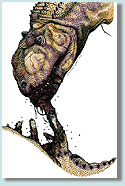 The exotic island of Madagascar, situated off the southeast coast of Africa, was a dangerous place to live 65 million to 70 million years ago. Crocodiles swarmed in the rivers, and a 30-foot-long, meat-eating dinosaur named Majungatholus atopus stalked the plains. Like most carnivorous dinosaurs, Majungatholus had teeth perfectly suited for ripping into flesh. But what was on the menu? Until now, this question has remained a mystery.
In a report published in the April 3 issue of the journal Nature, Raymond Rogers, a geologist from Macalester College in St. Paul, Minnesota, along with colleagues David Krause of the State University of New York at Stony Brook and Kristina Curry Rogers of the Science Museum of Minnesota, provide an answer. Majungatholus was a cannibal-—it regularly dined upon members of its own species. It also fed upon the remains of other dinosaurs, including gigantic long-necked sauropods called titanosaurs. The exotic island of Madagascar, situated off the southeast coast of Africa, was a dangerous place to live 65 million to 70 million years ago. Crocodiles swarmed in the rivers, and a 30-foot-long, meat-eating dinosaur named Majungatholus atopus stalked the plains. Like most carnivorous dinosaurs, Majungatholus had teeth perfectly suited for ripping into flesh. But what was on the menu? Until now, this question has remained a mystery.
In a report published in the April 3 issue of the journal Nature, Raymond Rogers, a geologist from Macalester College in St. Paul, Minnesota, along with colleagues David Krause of the State University of New York at Stony Brook and Kristina Curry Rogers of the Science Museum of Minnesota, provide an answer. Majungatholus was a cannibal-—it regularly dined upon members of its own species. It also fed upon the remains of other dinosaurs, including gigantic long-necked sauropods called titanosaurs.
Artwork courtesy: Demetrios M. Vital
Read the full story . ... Posted
4/2/03
|
 |
Liberty Bell Passes Stress Test
|
 |
| |
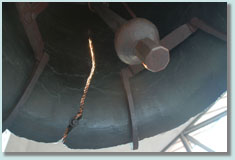 How do you move a wounded, 2,080-pound patriot? Very carefully. Recently, under the watchful eyes of curators, conservators, surveyors, and engineers, a team of riggers deftly lifted the fragile Liberty Bell off of the supports on which it has been resting for a quarter century and confirmed the bell can be safely moved into its new home this fall. Recognizable across the globe with its famous crack, the 250-year-old bell is remarkably frail for its size. Although the bell will move only 200 yards into the new museum, curators are taking every precaution to assure its safety. Steve Arms, president of MicroStrain, Inc., tracked movements of the metal along the crack using tiny, wireless sensors he developed as part of the NSF Small Business Innovation Research program. The devices are extremely sensitive, able to detect motion as small as 1/100th the width of a human hair. The researchers used custom attachments to place two metal sensors, originally developed for the semiconductor industry, on the metal around the bell's main crack. The team also hung a third sensor inside the bell to monitor potentially jarring rocking motions. How do you move a wounded, 2,080-pound patriot? Very carefully. Recently, under the watchful eyes of curators, conservators, surveyors, and engineers, a team of riggers deftly lifted the fragile Liberty Bell off of the supports on which it has been resting for a quarter century and confirmed the bell can be safely moved into its new home this fall. Recognizable across the globe with its famous crack, the 250-year-old bell is remarkably frail for its size. Although the bell will move only 200 yards into the new museum, curators are taking every precaution to assure its safety. Steve Arms, president of MicroStrain, Inc., tracked movements of the metal along the crack using tiny, wireless sensors he developed as part of the NSF Small Business Innovation Research program. The devices are extremely sensitive, able to detect motion as small as 1/100th the width of a human hair. The researchers used custom attachments to place two metal sensors, originally developed for the semiconductor industry, on the metal around the bell's main crack. The team also hung a third sensor inside the bell to monitor potentially jarring rocking motions.
Photo: Curt Suplee, National Science Foundation
Read the full story . ... Posted
4/1/03
|
 Top
of Page Top
of Page
|
|
|
 |
 |
 |
 |
 |
 |
 |
 |
|
 |
 |
 |
|
|

